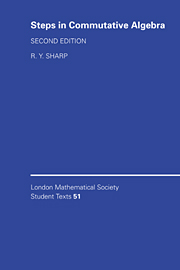Book contents
- Frontmatter
- Contents
- Preface to the 1st Edition
- Preface to the 2nd Edition
- 1 Commutative rings and subrings
- 2 Ideals
- 3 Prime ideals and maximal ideals
- 4 Primary decomposition
- 5 Rings of fractions
- 6 Modules
- 7 Chain conditions on modules
- 8 Commutative Noetherian rings
- 9 More module theory
- 10 Modules over principal ideal domains
- 11 Canonical forms for square matrices
- 12 Some applications to field theory
- 13 Integral dependence on subrings
- 14 Afflne algebras over fields
- 15 Dimension theory
- 16 Regular sequences and grade
- 17 Cohen–Macaulay rings
- Bibliography
- Index
15 - Dimension theory
Published online by Cambridge University Press: 06 January 2010
- Frontmatter
- Contents
- Preface to the 1st Edition
- Preface to the 2nd Edition
- 1 Commutative rings and subrings
- 2 Ideals
- 3 Prime ideals and maximal ideals
- 4 Primary decomposition
- 5 Rings of fractions
- 6 Modules
- 7 Chain conditions on modules
- 8 Commutative Noetherian rings
- 9 More module theory
- 10 Modules over principal ideal domains
- 11 Canonical forms for square matrices
- 12 Some applications to field theory
- 13 Integral dependence on subrings
- 14 Afflne algebras over fields
- 15 Dimension theory
- 16 Regular sequences and grade
- 17 Cohen–Macaulay rings
- Bibliography
- Index
Summary
In Chapter 14, we studied the highly satisfactory dimension theory for finitely generated commutative algebras over fields. Of course, finitely generated commutative algebras over fields form a subclass of the class of commutative Noetherian rings: in this chapter, we are going to study heights of prime ideals in a general commutative Noetherian ring R, and the dimension theory of such a ring.
The starting point will be KrulPs Principal Ideal Theorem: this states that, if a ∈ R is a non-unit of R and P ∈ Spec(R) is a minimal prime ideal of the principal ideal aR (see 8.17), then ht P ≥ 1. From this, we are able to go on to prove the Generalized Principal Ideal Theorem, which shows that, if I is a proper ideal of R which can be generated by n elements, then ht P ≥ n for every minimal prime ideal P of I. A consequence is that each Q ∈ Spec(R) has finite height, because Q is, of course, a minimal prime ideal of itself and every ideal of R is finitely generated!
There are consequences for local rings: if (R, M) is a local ring (recall from 8.26 that, in our terminology, a local ring is a commutative Noetherian ring which has exactly one maximal ideal), then dim R = ht M by 14.18(iv), and so R has finite dimension. In fact, we shall see that dim R is the least integer i ∈ ℕ0 for which there exists an M-primary ideal that can be generated by i elements.
Information
- Type
- Chapter
- Information
- Steps in Commutative Algebra , pp. 288 - 310Publisher: Cambridge University PressPrint publication year: 2001
